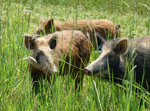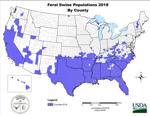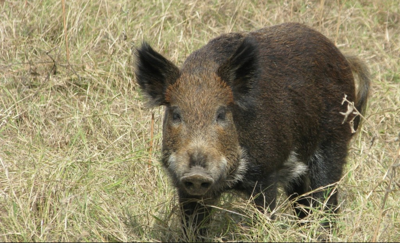It tastes like fish oil, has the mouthfeel of rubber and looks like a ball of earwax, but wild pigs are literally dying to eat it.
Louisiana scientists have patented a tasty but deadly bait that could help curb the rapid spread of feral hogs, an invasive species that causes widespread damage to croplands and coastal wetlands.
The patent, which federal authorities say will be made official next week, is the culmination of eight years of work by Louisiana State University animal researchers and chemists.

A feral hog bait developed by Louisiana State University researchers is a bouncy ball loaded with deadly dose of sodium nitrite.
“It was tremendous fun to work on this,” said John Pojman, chair of the LSU chemistry department. “It was a very applied problem, and one that can hopefully help the people in the state of Louisiana.”
Descendants of domesticated pigs, feral hogs eat or damage about $75 million worth of rice, soybean and other crops in Louisiana each year. They also gobble up imperiled species of salamanders and turtles, and raid the nests of shore birds and alligators.
Feral hogs consume such a massive quantity of acorns that few are left for deer, wood ducks and wild turkeys during lean winter months.
All that eating creates a lot of poop that often ends up in waterways. Recent DNA testing in streams and ponds in Allen, Vernon, Rapides and Natchitoches parishes found about half the test sites had dangerous levels of fecal bacteria from feral hog waste.
Hunting, poisoning and trapping aren’t doing nearly enough to reduce the hogs’ numbers. The state Department of Wildlife and Fisheries’ conservative estimates put the feral hog population at 900,000, but they could actually number 1.2 million. That’s more hogs across the state than humans in New Orleans, Baton Rouge and Metairie combined.
About 200,000 feral hogs are killed in Louisiana each year, but a death toll more than twice as high is needed just to maintain a static population, Wildlife and Fisheries scientists say.

More than 900,000 wild pigs live in Louisiana, causing damage to farms, forests and coastal wetlands. They are now found in every parish.
“What we have is just an endless fountain of pigs,” said Jim LaCour, a Wildlife and Fisheries feral hog expert.
That’s why the new bait is a much-anticipated addition to the state’s hog-fighting arsenal.
While the pigs seem willing to eat just about anything, they readily turn up their noses when they get a whiff of poison. The trick was finding something that was both delicious and lethal. LSU focused on sodium nitrite, a compound that, ironically enough, is used to cure bacon. But at the right dose, it eases pigs into an endless sleep.
Researchers crafted a bait recipe made of menhaden, a small fish also known as pogy, and potatoes. The pigs loved it, but the sodium nitrite made the concoction smell like bleach.
“The problem was that sodium nitrite will break down into different nitrogen oxide compounds and they have the smell kind of like a swimming pool — that chlorine smell — and they won’t eat it then,” Pojman said.

Feral hogs have spread across the South and are popping up in northern states like Vermont, Michigan and Washington. Image courtesy of the U.S. Department of Agriculture.
His lab solved the problem by adding the stuff that’s in heartburn medicine, which kept the acid levels low and halted the breakdown.
“It’s like we put in Tums,” Pojman said.
The scientists also worked hard to produce a pellet that didn’t crumble when a pig ate it, leaving leftovers for bear and other animals to consume. The end result is a chewy ball of gummy bear-like consistency.
“You can bounce them,” Pojman said.
Funding for the research came from the Pennington Family Foundation, Louisiana Rice Research Board and the Louisiana Soybean and Grain Research and Promotion Board.
The method of getting poison to pig isn’t perfect. To avoid killing other animals, the scientists created a “selective delivery system,” which is basically a portable bait dispenser that uses cellphone service-linked triggers and cameras to ensure only pigs get the poison.

Feral pigs eat from a feeder that dispenses corn and can also dispense lethal baits developed by LSU AgCenter researchers. This image was captured with a game camera.
“The only issue with the setup is that you might have to wake up at 3 a.m. to release baits,” LaCour said.
Plus, pigs "don't usually live where there's cell service," said LSU AgCenter researcher Glen Gentry, who helped lead the research.
LSU scientists are tinkering with other delivery methods, including what Gentry calls “the truffle approach.” The bait could be dropped into holes drilled into the ground, potentially along the perimeter of a farm. Unlike most animals, feral hogs are rooters that can easily smell buried food. Bears also dig up tasty things, so the method might not work where bears roam.
Another hurdle is getting federal approval to begin trials on the bait. Gentry applied for an experimental use permit more than eight months ago, but the U.S. Environmental Protection Agency has been slow to give the greenlight.
“We’ve run into roadblock after roadblock,” Gentry said.
For Acadia Parish farmer Charles Reiners, the bait’s approval can’t come too soon. He’s seen hog damage to his rice crop triple over the past 15 years.
“The pigs have destroyed as much as 10% of our rice fields,” he said. “It’s very, very frustrating. So the sooner we get LSU’s solution out here, the better. We want it in the field, and quick.”



















